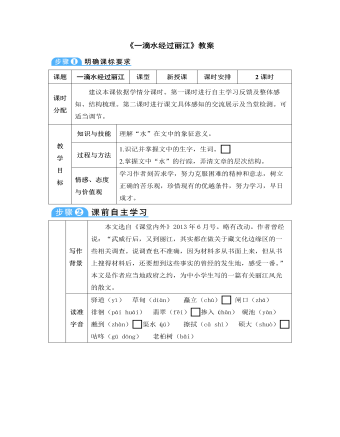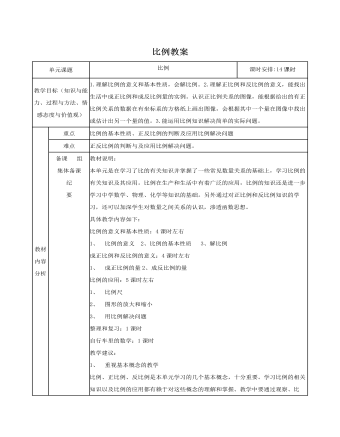-

人教版新目标初中英语七年级下册Don’t eat in class教案2篇
Don’t fight. =You can’t fight. (板书,教读)教师把这些句子板书在黑板上,并请学生大声整齐地读祈使句和“can’t”句型,并让学生注意两种句型表达形式的不同和转换,“Don’t …=You can’t…”;并对学生说:These are our school rules. (板书,教读) You can’t break the school rules. Don’t break the school rules.(板书,教读)步骤3 :Practicea. T: Now, each of the students is breaking one of these rules.Please finish 1a.学生看图,完成1a的内容,检查答案并大声朗读校规。b. 听录音,完成1b,选出四位学生都违反了哪条校规;听之前,学生要读会英文名。c. 请两位学生朗读1c部分的句型;要求学生两人一组对话表演,SA扮演外校转来新生,SB告知本校校规。(学生可经过讨论,多说出他们想到的校规,不必只限于书上;教师应给予帮助)2) 第二课时(2a~4)步骤1 :warming up of revisionT: What are the rules at your school?学生使用“can”或祈使句表达各条校规;其中老师可引出“eat in the cafeteria outside”的表达。步骤2 :Practicea.T: Christina is an exchange student. She doesn’t know the rules. Let’s listen, what activities they’re talking about?学生听第一遍时,完成2a;第二遍时,完成2b;b. 请学生领读2c部分,看着2a完成的表格,理解2c活动的要求;分成小组针对2a进行问答;

人教版新目标初中英语七年级下册It’s raining教案2篇
1 Each group choose one place to describe and what you are doing in it Choose one place, and describe what they are doing 2 Move around the room and give suggestions Talk about it and write it down 3 Ask one to show their works and act it Choose one of each group to make a report 4 Evaluate the best group and the best reporter Choose the best one Homework Ask your friends their ideal place and write about it教学反思:新课程标准中强调学生在课堂中的主体地位,在综合课中他们的主体地位就更加突出。在各个活动中给不同程度的学生不同层次的任务,让各层面的学生都有表现发挥的机会,从而产生对英语的兴趣。使用照片图片多媒体来辅助教学,效果更好。同时让了解其他国家风景,风俗的同学介绍ideal place,增加学生的背景知知识,实现跨学科交流的目的。教案点评:采用任务型教学模式,在各个活动中给不同程度的学生不同层次的任务,让各层面的学生都有表现发挥的机会,从而产生对英语的兴趣。使用照片图片多媒体来辅助教学,效果更好。让了解其他国家风景,风俗的同学介绍ideal place,增加学生的背景知识,实现跨学科交流的目的。

人教版新目标初中英语七年级下册Where did you go on vacation教案
句型: Where did you go on vacation? I went to summer camp.Did she go to Central Park?Yes,she did.No, she didn’t语法:一般过去时特殊疑问句、一般疑问句及肯、否定回答。课时安排4课时第一课时:Section A:la,1b,lc,2a,2b,2c 第二课时:Section A:3a,3b,4第三课时:Section B:1,2a,2b,2c第四课时:Section B:3a,3b,3c,4 and Self Check第一课时教学目标掌握描写假期生活的形容词。假期里自己所做事情的简单表达。谈论假期做的事情及当时情况。谈论假期时旅游的天气,旅游者以及食物等。教学过程一、导入播放一首英文歌曲:Let’s travel 说明:通过让学生听节奏欢快迪斯尼英语歌曲Let’s travel.引入本节课谈论的话题vacation and travel. 让歌曲使学生的思维活跃,增强课堂气氛,激发学生提高学习英语的兴趣。T:How is the trip ?Ss : It’s pretty good/ happy/exciting /relaxing/busy/dangerous/ fantastic说明:这个问题是为了操练形容词。建议让多个Ss作答。鼓励他们用不同的形容词。上述个别形容词本应在第二课时中出现,但可以在warming-up中第一次非正式出现。这些形容词也可在老师的评价语中适时出现,以加深学生对词汇的印象。

人教版新目标初中英语七年级下册How was your weekend教案2篇
Teaching Goal:1. General aims:Talk about recent past events2. Particular aims:A. Language Focus.Talk about recent past events and think of the past events.B. Language goalsHow was….?It was …What did …do over the weekend?C. Language structures:(1). How was your weekend? I was great. Pay attention to no form.(2). What did you do over the weekend? I played soccer. We went to the beach.D. Useful words and phrases:Words: was, did, went, beach, over, project, test, wasn’t, false, number, geography, spend, week, most, mixture, their, had, little, cook, read, saw, change, everyone, sit, sat, no, anythingPhrases: did one’s homework, played soccer, cleaned my room, went to the beach, played tennis, went to the movies, on Saturday morning, over the weekend, cook … for, what about, do some reading, have a party, talk show, go shoppingE. Grammar language:Present simple past tenseRegular and irregular verbsF. Learning strategies:Tour and holidaysG. Interdiscipinary:H. Emotion and manner:Teaching time: 5 periodsTeaching procedures:Period One教学步骤、时间 教师活动 学生活动 媒体应用Step 1Free talk 3’ Ask some questions like:Who’s on duty today?What’s the weather like? Answer and talk about something.让同学们回答下列问题1. Do you like weekend? (Let some students answer)It takes them three minutes to talk about the question.2. Why do you like weekend? (let the students answer) Most of the students like the weekend此时教师用汉语问:“在周末期间问你干了什么?这句话用英语这么回答?Let the students guess.At last the teacher give them right answer3. What did you do over the weekend?(板书、学习)

人教版新目标初中英语七年级下册What does he look like教案3篇
所需要用到的句子:Who is that?That is Jack. I like him.Why do you like him?I like him because he is interesting.Task 4: 设计理想中的人类Step one: 设计理想中的人类的外貌。把全班同学分成若干小组,学生可以边说边在纸上画出他们的模样。Step two: 设计理想中人类的性格。学生们可以把那些能描述性格的单词写在图画的旁边。Step three: 每组选出一名同学,其他同组同学提问,他作简单回答,并说明原因。所需用到的句子:What does he or she look like?He or she ...What is he or she like?He or she is ...Why?Because ...Task 5: 挑战性活动调查性格是天生的还是后天形成的,让每个同学回家去调查一下自己成长过程中性格是否有变化,具体是怎样的,为什么会这样? Teaching Aims:1. Enable students to have a general understanding of how to talk about people's physical appearance.2. Enable students to tackle some essential vocabularies and patterns about describing people. Provide them with necessary skills and methods.3. Create various chances for students to describe the persons they're familiar with, such as classmates, family members, teachers, idols, etc.

人教版新目标初中英语七年级下册I ’d like some noodles教案
教学过程Step 1: warming-up Sing a song---------“food and drink” Step 2: Revision1 Dictation2 Revise: What kind of noodles would you like?I’d like …What size bowl of noodles would you like?I’d like…Step 3: Presentation1 show pictures of food, ask students say the words.2 Students read the newspaper ad in 3a. Fill in blanks with words in the box. Then read the ad together, the teacher explains some difficult language points.3 Check the answers Step 4 PracticeAsk students to finish 3b in the same way according to 3a. Students read the short passage and fill in the blanks .At last, check the answers.Step 5 productionAsk students to write their own ad for dumplings, noodles, drinks, and other foods they know. Then ask students to read their partner’s ad. Then order food and drink from their partner.Step 6 Home workGroup work – make an ad about “food and drink”

人教版新目标初中英语七年级下册I want to be an actor教案2篇
三、教学建议第一课时:1. Lead in (Vocabulary)A) Before class, teacher should collect some pictures of working places. For example: Bank, TV Station, Restaurant, Police Station, Hospital ...B) In class, show students the pictures (PowerPoint, OHP). Ask students to tell the name of the working places and the name of the jobs.Shop assistant, doctor, actor, reporter, police office, waiter, bank clerk, studentC) Do exercise 1a and 3a.2. Bingo GameAsk groups of students to make up pairs of cards with a job on one and the related workplace on the other. For example, waiter / restaurant, teacher / school, doctor / hospital. Encourage students to use both the job / workplace combinations in the book and the ones that students came up during class discussions. Be sure they have twice as many sets of cards as there are students in the group. They can make two sets of cards for a single job / workplace, if necessary. Then have each group mix up its set of cards and hand their cards out in random order. Each time a student gets a pair of cards that match, he or she can lay these cards down. The goal is to have no cards in your hand at the end.3. Task OneA) Ask students to work in pairs and ask the partner what does he / she want to be in the future.e. g. :What do you / does he / does she want to be?I want to be a.Why?Because it's (adj).B) Vocabulary: Section B, 1a4. Homework 1.2.

人教版新目标初中英语七年级下册Where is your pen pal from教案
2.1Match the country with the language.Step II Reading3a? let the students read the letter fast and answer the questions.? Let the students ask more questions about the letter as possible as the can.Step III Writing3b.Step IV. Pairwork2cStep V Listening2a, 2bStep V. HomeworkExercises book(1) P3Exercises book (2) P3Period FourStep I . Dictate the words and sentences in Unit1.Step II. Self-checkStep III. Check the answers for Exercises book in the unit.Step IV. Home workRevise and preparation for unit 2.教学反思:通过本单元的学习,学生基本可以谈论人们的国籍,居住城市及其所说的语言,通过书信方式去介绍自己并寻找笔友。但在涉及到国外的一些城市时,学生对这方面的知识相对欠缺,能介绍的城市并不多,也反应出学生课前预习不充分,这跟学生学习条件也有关,大多数学生无法通过网络获取所需信息。因此,在以后的教学中要多指导学生通过计算机网络获取信息,拓宽知识面。

人教版新目标初中英语七年级下册What do you think of game shows教案
五、教学Section B-2c1. Pair work: What do you think of the belt/sunglasses/…? What does your father/mother/… think of your scarf/belt…?2. Group work(1). Teacher shows some different kinds of school uniforms (制服)and asks : “ What do you think of your school uniforms? If you have a chance to choose your school uniforms, what kind would you like to choose?”(2). Discuss in groups.(3).Get some Ss to report in class.说明:这一步旨在让学生运用已有的语言知识谈论对事物的看法和意见,并简单阐明理由,培养学生的主动思维能力和运用英语的能力。六、教学拓展调查电视节目的收视率任务:调查你周围的人对现在各种电视节目的反响。活动过程:1.教师布置任务,让学生调查周围的人(包括他的亲戚朋友和邻居)喜欢收看哪方面的电视节目。2.学生进行调查活动,运用本单元所学的句型What do you think of….? (Why?)What's your favorite game shows?What do you think of talk show?I doesn’t mind it.I like it.I love it.I can’t stand it.3.记录下排在前10位的TV Program,填写调查表,比较其收视率。

人教版新目标初中英语七年级下册Why do you like koalas教案2篇
单元整体说明(一)单元教材分析本单元的核心话题是描述动物和表达个人喜好,以及句式why do you like…? Because…。这也是本单元的教学重点。通过本单元的学习,学生应能较流利地运用所学词汇和句型描述动物,表达个人喜好。(二)单元知识结构1.词汇动物名称 tiger, elephant, koala, dolphin, etc.词汇描述性形容词: smart, cute, ugly, clever, shy, etc.国家名: Australia, South Africa2.句型Why do you like koala hears? Because they are cute.Where are pandas from? They're from China.What animals do you like? I like dolphins.(三)单元整体目标1.Master the vocabulary2.Master and use: Why do you like koalas? Because they am cute.Where are pandas from? They're from China.What animals do you like? I like dolphins.(四)单元教学重难点一览(五)单元学情分析学生此前已经学过由why, where, what 引导的特殊疑问句句型,具有了学习本单元知识的认知前提。形形色色的动物能激发学生的好奇心,产生了解它们的欲望,这有利于本单元知识的教学和学生学习兴趣的培养。

部编版语文八年级下册《一滴水经过丽江》教案
【感悟精彩句子】1. “今天,一架大水车来把我们扬到高处,游览古城的人要把这水车和清凉的水作一个美丽的背景摄影留念。”写到大水车的用意是什么? 大水车是丽江古城的标志性建筑,成为了丽江古城的地标,也是游客们一定要去拍照留念的地方。历史足迹明显,地域特色突出。2. 一些薄云掠过月亮时,就像丽江古城中,一个银匠,正在擦拭一只硕大的银盘。联想,古城的民俗难以忘怀。3.“我知道,作为一滴水,我终于以水的方式走过了丽江。”这样的结尾,体现了一滴水怎样的情怀?〖ZK)〗欣赏了风景如画的丽江,考察了“土”味浓郁的建筑,体会了丰富多彩的民俗民风,美感袭身,皆满足矣。融入更加广阔的江海,开始一滴水热情、奔放的新生活。

大班数学活动《学习6—9的相邻数》课件教案
2、学习与同伴友好交往、合作游戏的方法。3、培养幼儿的动手操作能力、迁移能力和逆向思维。活动准备: 1—10数字一套;录音带、录音机;幼儿学具: 1—10的纸牌。活动预设:1、游戏《拍手问答》复习5以内的相邻数。教师边拍手边问,幼儿边拍手边回答。如教师问:小朋友,我问你,3的朋友是几和几?幼儿回答:x老师,告诉你,3的朋友是2和4。(可请个别或集体回答)2、游戏《认邻居》:请若干幼儿自选楼房居住,并认识自己的邻居。学习6的相邻数。知道其与前后数的关系。3、游戏:纸牌乐,两个幼儿为一组。游戏开始,把1—10的纸牌放在桌面上,两个幼儿猜“剪刀石头布”,赢幼儿先取一张纸牌,输的幼儿找出它的相邻数。游戏再次进行,教师巡回指导。

中班数学:开宝箱—认识数字9课件教案
【活动目标】1. 认识数字9,能正确感知9以内的数量。2. 会按一定规律进行点数且排序。3. 在开启百宝箱、分享糖果的过程中体验数字游戏的快乐。 【活动准备】 材料准备:圆点和图案相匹配的信封若干个,自制大信封、密码箱各一个,三个内装提示语的神秘小盒,糖果若干。 经验准备:幼儿对5-8以内数量有初步的认识。 【活动过程】1. 兴趣导入 师:小朋友,我们都看过动画片《喜羊羊和灰太狼》。你们想请喜羊羊来做客吗? 师:(音乐声中出示布偶)喜羊羊来了!还给我们带来了一箱礼物呢!让我们一起来打开看看吧!哎呀,怎么打不开?噢!原来是一只有密码的百宝箱!2.展开游戏 (1)寻找打开百宝箱的方法 师:我们怎么才能打开这个百宝箱呢? 幼儿:输入密码,就能打开了。 师:那密码是什么呢?大家看一看密码箱的密码,由几个数字组成?(5个)猜猜会是由哪些数字组成的呢?(试用幼儿说的数字开箱)噢,还是打不开!(作和布偶耳语状)喜羊羊说啦,密码就藏在3只神秘的盒子里!快找一找神秘盒在哪里!

中班数学 :《一样的小熊在哪里》课件教案
一:活动目标1、 能按顺序的进行细致的观察,将衣着相同的两个小熊找出来;2、 提高幼儿的视觉辨别能力。二:活动准备1:挂图:〈〈视觉辨认〉〉;2:幼儿用书:〈〈我的数学〉〉第22页;3:小熊卡片24张,裤子线条、颜色一样的,各6张,分4组;4:水彩笔、粉笔。

人教版新课标小学数学六年级下册负数教案
(3)教师在黑板上话好直线,在相应的点上用小图片代表大树和学生,在问怎样用数表示这些学生和大树的相对位置关系?(让学生把直线上的点和正负数对应起来。(4)学生回答,教师在相应点的下方标出对应的数,再让学生说说直线上其他几个点代表的数,让学生对数轴上的点表示的正负数形成相对完整的认识。(5)总结:我们可以像这样在直线上表示出正数、0和负数,像这样的直线我们叫数轴。(6)引导学生观察:A、从0起往右依次是?从0起往左依次是?你发现什么规律?B、在数轴上分别找到1.5和-1.5对应的点。如果从起点分别到.5和-1.5处,应如何运动?(7)练习:做一做的第1、2题。(二)教学例4:1、出示未来一周的天气情况,让学生把未来一周每天的最低气温在数轴上表示出来,并比较他们的大小。

人教版新课标小学数学三年级下册年、月、日教案
大家请看,钟面上现在表示的是几时?(下午1时)下午1时我们还可以怎样表示?(13时)下午1时就是13时,你是怎么想到用13时表示的?在一日内,由于第一圈走了12小时,所以时针在走第二圈时,我们就要把时针指的钟面上的时刻数分别加上12,这就是我们今天要学习的24时记时法。比如,现在钟面上是下午1时,根据24时记时法就应该是?(13时)。那么下午2时、3时、6时、晚上7时30分、9时50分用24时计时法怎样表示?你是怎样想的?(继续看画面。)这时,同学们又开始了下午的学习生活。16时,同学们结束了一天的学习,回到了家中。时间一晃就到了21时,也就是我们常说的夜间九点。这时我们又该上床休息了。时间一分一秒地过去了,又是午夜12点,夜深人静,一天又过去了。这种用0时到24时来表示一天时间的记时方法我们就把它叫做24时记时法。师小结:同学们,一天的时间很快就会过去,我们要珍惜时间,合理地安排好一天的作息时间。4、观察钟面:你发现了什么?(同一指针可以表示晚上12时、0时、24时。)抽几个时间板书。观察普通计时法和24时计时法,发现他们有什么区别呢?同桌之间互相交流一下。

人教版新课标小学数学三年级下册面积教案
教学内容:书上第84页公顷、平方千米教学目标:1、让学生知道公顷、平方千米是更大的面积单位,了解1公顷、1平方千米的实际大小。2、知道1公顷=10000平方米,1平方千米=100公顷。3、培养学生的空间观察和动手操作能力,培养学生的爱国主义情感。教学重点:使学生了解1公顷、1平方千米的大小。掌握土地面积单位间的进率。教学难点:建立1公顷及1平方千米的实际概念,能区分两个单位。教学准备:课件教学过程:一、巩固旧知,作好铺垫。1、常用的面积单位有哪些?2、用打手势表示一下1平方厘米、1平方分米、1平方米的大小。3、填写正确的面积单位:指甲的面数学书本的封面黑板的面二、引入:同学们,我们一起来看看体育场的图片,你们有什么感想?出示:(体育场太大了)那还能用我们前面学过的面积单位进行测量吗?这就是我们今天要学的比平方米更大的面积单位:公顷和平方千米。(出示课题:公顷、平方千米)三、新授1、通常我们在测量土地面积时,要用到更大的面积单位,公顷和平方千米。它们到底有多大呢?这节课我们就来了解一下。

人教版新课标小学数学六年级下册统计教案
分别算出2008年比2007年各季度增产的百分数和合计数,再制成统计表.分析:根据题目要求,要算出各季度增产的百分数,我们只要根据2008年与2007年各个季度的原始数据,运用“求一个数是另一个数的百分之几”的方法就可以算出.算出了各个季度增产的百分数,根据题意制统计表时,既要按照季度分类,又要反映出年份的类别,所以在确定表头时可分为3部分:年份、台数、季度,年份又分为2007年产量、2008年产量、2008年比2007年增产的百分数.2、田力化肥厂今年第一季度生产情况如下:元月份计划生产1500吨,实际生产1620吨;二月计划生产1600吨,实际生产1680吨;三月份计划生产1640吨,实际生产1720吨,根据上面的数据,算出各月完成计划的百分数,并制成统计表.(1)制作含有百分数的统计表时,百分数这一栏一定要写清楚是谁占谁的百分之几,并按“求一个数是另一个数的百分之几”的解题方法正确算出对应百分数”

人教版新课标小学数学六年级下册比例教案
一、回顾旧知,复习铺垫1、上节课我们学习了一些比例的知识,谁能说一说什么叫做比例?比例的基本性质是什么?应用比例的基本性质可以做什么?2、判断下面每组中的两个比是否能组成比例?为什么?6:3和8:4 : 和 :3、这节课我们继续学习有关比例的知识,学习解比例。(板书课题)二、引导探索,学习新知1、什么叫解比例?我们知道比例共有四项,如果知道其中的任何三项,就可以求出这个比例中的另外一个未知项。求比例中的未知项,叫做解比例。解比例要根据比例的基本性质来解。2、教学例2。(1)把未知项设为X。解:设这座模型的高是X米。(2)根据比例的意义列出比例:X:320=1:10(3)让学生指出这个比例的外项、内项,并说明知道哪三项,求哪一项。根据比例的基本性质可以把它变成什么形式?3x=8×15。这变成了什么?(方程。)教师说明:这样解比例就变成解方程了,利用以前学过的解方程的方法就可以求出未知数X的值。

部编版语文九年级上册《刘姥姥进大观园》教案
2.这篇课文细致地描写了各具情态的笑,给人留下了难忘的印象。请说说主要人物的笑有什么不同,反映了他们怎样的性格特点。明确:凤姐、鸳鸯的笑而不露,反映出她们善于计谋,爱耍小手段、取笑、捉弄人的性格特点;史湘云“掌不住,一口茶都喷出来”,反映出她的率真、爽朗、不受拘束的性格;林黛玉“笑岔了气,伏着桌子只叫‘嗳哟!’”,可见她的笑是极力控制,反映出她含蓄、有教养而又谨慎的性格;宝玉笑时钻到贾母的怀里,反映出他的天真、孩子气,也写出了贾母爱孙之心;探春手里的“茶碗都合在迎春身上”,反映了她率真、爽朗、不受拘束的性格特点,也可以看出她要强的个性;惜春笑得肚子疼,让奶母给揉肠子,反映出她娇气、孩子气;“王夫人笑的用手指着凤姐儿,只说不出话来”,写出王夫人已知道是凤姐导演的,但又不便张扬的心理,也保持了雍容与尊贵。

